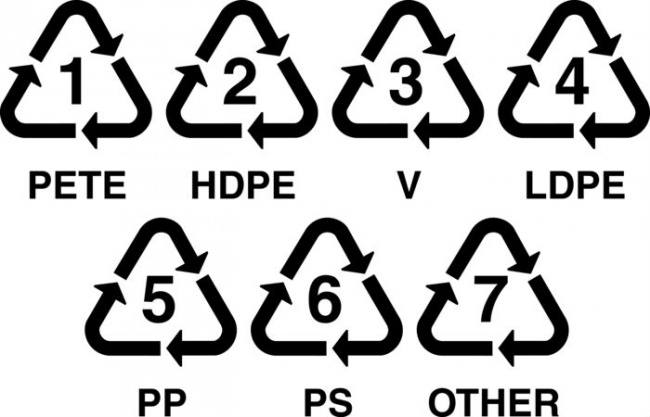Our daily lives are filled with plastic, from tupperware to water bottles. Some plastic containers are safe for human consumption while others are potentially hazardous to your health.
Take a look around your kitchen. Are you sure your plastic is safe and non-toxic? To avoid risking your health, make sure to be familiar with the different types of plastic on the market today.
A simple glance, usually at the bottom of the container, is all you need to identify the material. Plastic is marked with a number, 1 through 7, and/or a set of letters that label its chemical composition. Like this:
Take a look below to find out what each one means.
Type 1: PETE or PET
PET plastic is clear, 100% recyclable, and most commonly used for drinks, mouthwash, and microwavable meal trays. In general, this plastic is considered safe for food and drink storage, although consumers should take some precautions.
It should be stored at room temperature. High temperatures can increase the levels of the chemical antimony, which is a potentially carcinogenic material. The rule of thumb with this plastic is to only use it once, as reuse can lead to bacterial build-up.
Type 2: HDPE or HDP
HDPE plastic is slightly harder than PET and has a very high strength-to-density ratio. Type 2 plastic is not transparent and has dye added for marketing purposes, which means it can come in many different colors. It is used to manufacture detergent bottles, milk jugs, and freezer bags. So far, experts have not found toxic chemicals in its composition. HDPE is not likely to leach into liquids, making it safe for food and drink storage.
Type 3: PVC or 3V
PVC plastic is potentially harmful to human health. It is used to make plastic cling wrap as well as some toys for children and pets. Type 3 plastic contains phthalates that may be related to reproductive complications in humans and animals due to chemicals that can affect hormonal production. These chemicals can easily leach into lipid-containing substances and have also been linked to asthma in children.
Type 4: LDPE
LDPE plastic is flexible and solvent-resistant. Often used in frozen food, bread, and garbage bags as well as squeezable condiment bottles, it is not known to leach chemicals into food. It can also be found in the lining of paper milk cartons. Its production is considered hazardous but its use is considered low hazard. Many people feel more comfortable avoiding it.
Type 5: PP
PP plastic is harder than other plastics and semi-transparent. Common uses for this plastic include yogurt bottles, medicine containers, and margarine and butter tubs. This plastic can be placed in the microwave and reach high temperatures without melting. This means PP plastic containers do not risk leaching into their contents and are therefore safe for storing foods and drinks for human consumption.
Type 6: PS
Polystyrene, or PS, plastic is used in foam insulation, egg cartons, styrofoam drinking cups, and take-out containers.
Avoid using styrofoam materials for food and drink. This plastic is not safe when heated and does leach carcinogenic chemicals into food. Specifically, styrene can contaminate the contents. Styrene has been linked to an increased risk of lymphoma and leukemia. It has also been linked to lung tumors in lab animals. Even hot water and coffee served in styrofoam cups has been found to have increased levels of styrene. This plastic should not be utilized for long-term storage.
Type 7: PC or Non-Labeled
PC, Type 7, or any non-labeled plastic should be avoided whenever possible. This category is used to describe packages made of chemicals and resins that are not found in the previous six types of plastic. It is a hard, nearly unbreakable plastic. Polycarbonates contain bisphenol A (BPA) which leaches into container contents. Despite its dangers, it is often used for sports bottles, baby bottles, and water cooler bottles.
Read Labels!
Before purchasing any plastics, try to read the numbers and/or letters stamped on the bottom of the container. Try to avoid numbers 3, 6, and 7. Be careful with all plastic containers and don’t let them overheat or store food for too long. Glass containers are preferable.
Featured photo credit: www.pixabay.com via pixabay.com













































